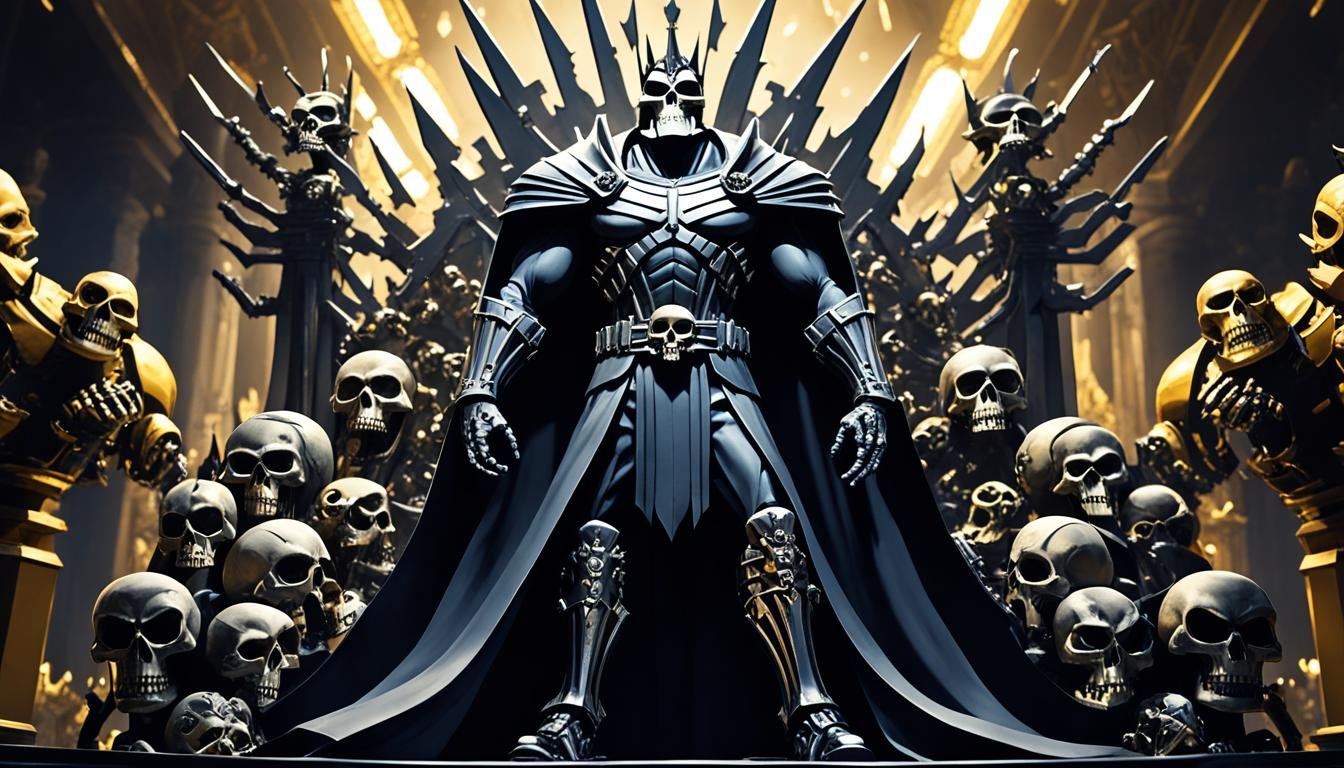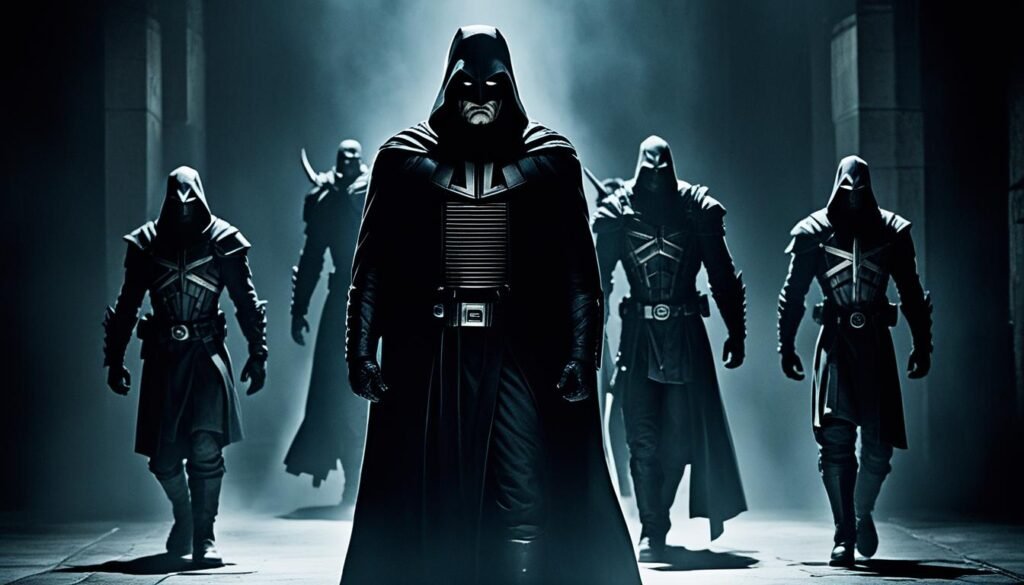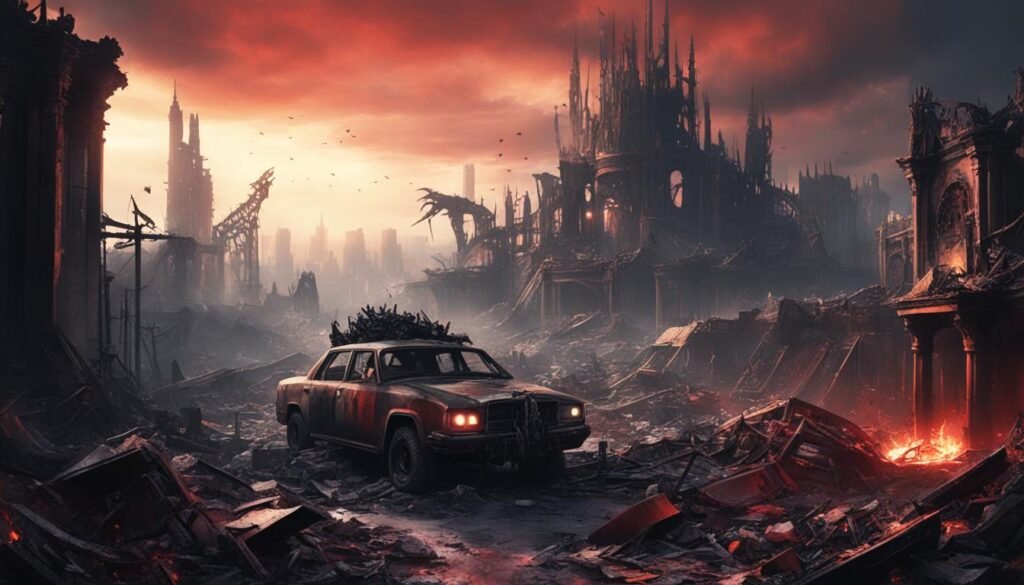

In today’s stories, villains are more complex than ever, especially those in charge. These dark leaders of evil groups show us deep stories. They reveal why they do what they do. This piece looks at how these wicked leaders shape their stories. We also see how their choices affect the villainous teams they command. Let’s dive into the world of villain leaders and see what it’s like to lead from the shadows.
Table of Contents
ToggleKey Takeaways
- Understanding the significance of villain leaders in storytelling.
- Exploring the traits that make a successful wicked leader.
- Examining the complex morality of villain protagonists.
- Analyzing recruitment strategies used by villain organizations.
- Investigating the consequences of dark empire leadership.
- Assessing the impact of villain teams on popular culture.
Introduction to Villain Organizations
Villain organizations are key in stories, creating the main conflict. These groups are known as evil organizations or sinister groups. They have a clear structure with strong leaders and loyal members. These members are all about doing bad things.
When there is a dark empire, the story gets more intense. Heroes must overcome tough challenges. This tests their limits and makes them grow. It brings up big questions about right and wrong. These questions grab viewers and keep them interested.
These villain groups have their own purposes. They stand against the heroes, adding layers to the story. To learn more about these bad leaders, click here this informative resource.
Understanding the Role of a Wicked Leader
The realm of villain organizations shows how leadership works under a wicked leader. These leaders manipulate those around them and their followers. They use their charm, smart strategies, and understanding of what makes people tick.
Charisma, strategic thinking, and seeing into people’s motivations are key. They help build power and loyalty in a bad leadership setup.
The Traits of a Successful Villain Leader
A successful villain leader has important traits for dark leadership. These traits include:
- Charisma: This trait draws in people, creates loyalty, or fear, making the leader strong.
- Strategic Thinking: Seeing the big picture helps make plans that push their evil goals.
- Emotional Intelligence: Knowing what others feel helps use them for certain aims.
- Decisiveness: Making swift, sure decisions sets them apart from others.
The Importance of Charisma in Dark Leadership
For a wicked leader, charisma is key in the world of villain organizations. This quality deeply affects their ties with followers and enemies. A charismatic leader builds strong connections, influencing how followers think and act.
This mix of charisma and power is central in stories about villains. Followers get caught up in the leader’s vision, driven by motivational speech. This keeps them loyal to their dark cause.
i became the leader of a villain organization characters
Stories about characters who become the heads of villain organizations are fascinating. They start as ordinary people and become something much more. Through their unique backstories, we see how they turn into villain protagonists or antiheroes. Learning about their pasts helps us understand why they took such a path.
Notable Characters and Their Backstories
Many characters have interesting stories of how they rose to be leaders. Their past often includes hurt, tough choices, or a burning need for revenge. For example:
- Character A: Used to be a hero but felt betrayed. This led them down a darker road.
- Character B: Driven by the need to get back at those who took everything from them.
- Character C: All about gaining power, using charm to bring others into their vision.
We get to see the battles within these villain leads. It shows how deeply personal experiences shape their motives.
Their Motivations and Goals as Leaders
These characters have different reasons for leading villain organizations. They might seek:
- Power: They want to be in charge, using force or clever plans.
- Revenge: They aim to get back at those who hurt them.
- Ideological beliefs: They follow a set of ideas, wanting to change the world.
These drives make the characters feel real and connect to the audience. Understanding their deep desires shows the complexities of being an antihero. This insight makes stories more engaging and thought-provoking.
Through these tales, we explore the layers of villainy and leadership. It challenges our views on right and wrong. It also offers a new look at what it means to have power.
The Dynamics of Corrupt Leadership
Corruption greatly changes how a villain organization works. It causes problems inside and stops these groups from reaching their goals. When we look into how evil organizations become corrupt, we find a complex mix of reasons and fights. These often lead to battles for control and disagreements within the group.
How Corruption Shapes Villain Organizations
Corrupt leaders cause chaos in villain groups. They focus on their own needs, making the organization forget its main purpose. This leads to members facing tough choices between power and being loyal.
- Conflict Among Members: Different goals cause divisions.
- Decreased Efficiency: People focus more on their own power rather than working together.
- Erosion of Trust: As corruption grows, openness decreases.
Case Studies from Popular Media
Looking at examples from movies and TV shows helps us see how corrupt leadership works in real life. Famous examples show how characters deal with corruption and what happens next. Here are some important examples:
| Media Title | Character | Corruption Example | Impact on Organization |
|---|---|---|---|
| Breaking Bad | Walter White | Turning to meth production | Fragmented partnerships and betrayals |
| The Dark Knight | Harvey Dent | Becoming Two-Face | Chaos and moral decay |
| House of Cards | Frank Underwood | Manipulating political power | Corrupt leadership leads to systemic decay |
These examples show the different ways corruption affects villain groups. They also show how it changes the leaders and the story. By studying these characters and why they do what they do, we learn a lot about corrupt leadership. We see its effects on both people and their groups.
The Evolution of Villain Protagonists
Storytelling has shifted, bringing the antihero to the forefront. This character type explores the gray areas of morality. They are not just good or evil. This makes us think about what we believe is right or wrong.
Antiheroes and Their Complex Morality
Antiheroes show the complex side of being human. They show us that in certain situations, what seems wrong might not be. These characters face tough choices and mixed feelings. By understanding their decisions, we see things differently.
Representation in Modern Storytelling
Today, stories are more focused on morally complex characters. These characters come from all walks of life, showing their importance in our culture. Their stories help us talk about big ideas like freedom and responsibility in a confusing world.
The League of Villains: A Case Study
The League of Villains is a standout example in a famous media world. It was started with a clear goal, making a big mark on hero society. Key members like All For One and Tomura Shigaraki drive its dark goals.
Founders and Key Members
All For One started the League of Villains with evil goals. Tomura Shigaraki took his place as a leader, sharing his vision. Each member adds their special skills and reasons, making the team dynamic. The diversity of these villains shows how complex their leadership can be, as seen in this study.
Impact on Hero Society
The League’s effect on heroes is huge. It puts heroes to the test, causing them to adapt. This back-and-forth shapes stories and changes how the public sees heroes. The battles lead to more complex stories, as discussed in the League of Villains.

Building a Sinister Group: Recruitment Strategies
Villain groups use smart ways to add members. They use mind tricks and exciting promises to attract people feeling left out or unhappy. Here are some tactics they often use to get new members.
How Villain Organizations Gather Members
Methods used by villain groups include:
- Playing with emotions to make people feel they must join quickly.
- Offering power, high status, or control, tempting for those wanting more from life.
- Creating a supportive space where people can share their problems and anger.
The Psychology Behind Joining a Sinister Group
The reasoning for joining bad groups is complex, tapping into deep needs or wants. Common reasons people join include:
- Seeking a sense of belonging with others who think the same way.
- The allure of power for those feeling powerless.
- Wanting revenge for wrongs they feel have been done to them, with the group offering a way to get back.
The Consequences of Dark Empire Leadership
Leaders in dark empires use control tactics to stay in power. They couple domination with strategic moves to rule. Understanding these methods helps see their impact and the moral questions they bring up.
Domination and Control Tactics
Leaders deploy tactics to make people afraid and loyal. They use fear to keep others from challenging them. And, they manipulate stories to control what people think. Also, leaders make temporary alliances to fight off threats.
Such a focus on control might work for a while. But it usually ends up causing trouble within their ranks.
Potential Downfalls of a Dark Empire
Even the strongest dark empires can face big problems. Here are some common issues:
- Betrayal from within: Members might not trust each other, leading to plots against the leader.
- Overreach: Trying to do too much can spread resources too thin and create weak spots.
- Heroic counteraction: Heroes often stand up to these empires, threatening their control.
These issues warn characters and audiences alike. They show that seeking power through fear usually ends in insecurity and chaos.

Thematic Exploration of Villainous Teams in Media
The portrayal of villainous teams in movies and literature is fascinating. It allows for a deep look into themes like conflict and loyalty. We also see how villains battle for power.
Analyzing stories shows how villain groups are important. They challenge the heroes, making the story richer.
Analyzing Popular Movies and Books
Films and books reveal a lot about villainous teams. They show how these groups operate and what they want. For instance, “The Avengers” and “Suicide Squad” show different types of teamwork.
These stories dive into the complexity of the characters. We see themes of betrayal and friendship. This helps us see how villainous teams are like reflections of real-life.
The Influence of Villain Teams on Popular Culture
Villainous teams greatly impact popular culture. They shape how we see heroes and villains. These groups show us the darker sides of humanity.
Their stories make us think about our own values. Villain teams are essential in storytelling. They have shaped media for many generations.
Conclusion
We dive into the dark world of villain organizations and their leaders, exploring the fascinating side of evil leadership. These characters have various reasons for their actions, like seeking revenge or following an ideology. This quest for power makes them crucial figures in stories and media. Understanding their motives helps us get more out of the stories we follow.
The way these villain groups work together shows us a lot about leadership and what draws people to dark sides. By looking into how villain leaders charm and influence, we begin to see why they fascinate us. This challenges our usual ideas of good and bad, making us think deeper about morality.
Studying villains and their groups helps us see why they matter in stories. Even in dark themes, there are gripping tales to be found. Getting into these stories lets us understand them better. It also makes us ponder the ethical challenges they introduce.
FAQ
What defines a villain organization in storytelling?
A villain organization has a strict order, a clear mission, and a major role in conflict. They challenge the heroes and delve into themes like power, right and wrong, and dishonesty.
What traits should a successful wicked leader possess?
Great villain leaders have charm, can think ahead, and know what drives their people. These abilities let them twist others and norms to reach their bad goals.
How important is charisma in dark leadership?
Charisma is key for gaining and keeping control in villain groups. A leader’s charm can spark devotion or fear. This greatly helps them succeed and influences their bonds.
Can you name some notable villain characters who became leaders of organizations?
Many known characters have led villain groups, faced personal hurdles, and chased goals. Their stories show their complex reasons and touching aims.
What role does corruption play within villain organizations?
Corruption leads to fights for power and can turn groups away from their goals. It shows the hard choices and questions leaders and their teams face.
How does the concept of the antihero complicate traditional morality?
Antiheroes mix up what’s seen as good or bad, bringing out moral puzzles that appeal to people. Their changing stories make us rethink misdeeds and morals in today’s tales.
What can we learn from the League of Villains as a case study?
The League of Villains shows how leadership and beliefs shape a group’s goal and interactions with heroes. This makes for engaging stories.
What strategies do villain organizations use to recruit new members?
They use trickery, appeals to feelings, and offers of power to recruit. Understanding these methods shows how evil groups grow and allure those seeking a place, strength, or payback.
What are some common pitfalls faced by leaders of dark empires?
Leaders often face betrayal, going too far, and battles with heroes. These dangers are lessons, showing how fragile control is in evil circles.
How do villainous teams impact popular culture?
Villain teams influence how we see heroes and villains, mirroring our fears and wants. They affect the making of stories and culture across different media.

As a trusted news source, Editorial Fox prides itself on upholding the highest standards of journalistic integrity. Our commitment to accuracy and fairness ensures that our readers can rely on us for reliable information.
Mail: info@editorialfox.com
About Editorial Fox
At Editorial Fox, we are committed to delivering high-quality journalism that informs and engages our readers. Our team of experienced journalists and editors work tirelessly to bring you the latest news and analysis from around the world.
Copyright @2024 Editorialfox.com All Right Reserve.


Be the first to leave a comment